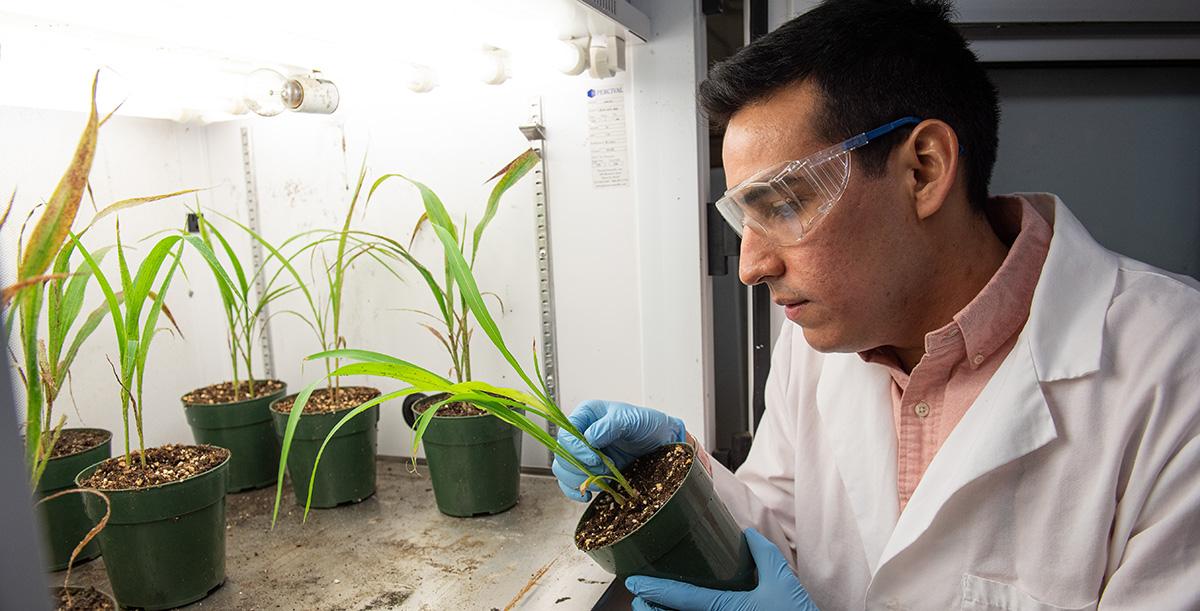A pesky pest
Entomologist uses AI to spot tiny insect
By Pat Melgares

Ivan Grijalva looks over plants in his lab for evidence of the sugarcane aphid. Grijalva, doctoral student in entomology, is among a group of researchers using artificial intelligence to simplify identification of the leafsucking insects.
Ivan Grijalva considers the sugarcane aphid a big headache.
Strange, perhaps, since it would take about 16 of the pear-shaped, soft-bodied, leaf-sucking insects — lined up end to end — to measure 1 inch. In a farm field, aphids are rarely visible at first glance, even though hundreds or thousands may be present.
Trivial? Not to Grijalva, Kansas State University doctoral student in entomology, who is using machine learning to detect and classify sugarcane aphid populations on sorghum leaves without the use of manual labor.
“Using digital cameras, we collect images of the aphid on leaves while scouting farm fields, then we create computer algorithms that are able to detect and classify different densities of the sugarcane aphid on leaves,” Grijalva said.
Technology is key to bringing all the pieces together.
“Nobody likes to count aphids,” said Brian McCornack, entomology department head in the College of Agriculture and Grijalva’s advisor. “It’s tedious, and we need ways to standardize yet simplify the process. We can provide growers with all the information needed to manage a field, but we need to make decision tools accessible. A lot of the time, it comes down to a number: How many bugs are in my field, and what do I do about it?”
The more images researchers take of infested leaves, the more reliable the algorithm. The artificial intelligence gained ultimately allows machines to recognize infestations and eliminates the need to count aphids manually.
“Automated detection with images makes it entirely possible to confirm the presence of an insect pest and potentially target insecticide applications for precise control with the aid of robotics,” Grijalva said.
That is in line with what is known as Integrated Pest Management, or IPM, which is an environmentally sensitive approach to pest management that relies on a combination of cost-effective control tactics.
“Pest identification and monitoring, use of economic threshold levels and applying insecticides only when justified are current practices in IPM that we need to use to make a giant leap toward securing food production for a growing world population,” Grijalva said. “Our project will enable scientists to provide management recommendations to growers to maximize the efficiency of insecticides while minimizing the negative impacts on the environment.”
Grijalva also is involved in a project with Ajay Sharda and Dan Flippo — both associate professors in the Carl and Melinda Helwig Department of Biological and Agricultural Engineering in the Carl R. Ice College of Engineering. The researchers are using machine learning to recognize aphids under sorghum canopies, which then triggers a ground robot to spray it.
“The impact of digital agriculture on today’s farms is tremendous,” Grijalva said. “With the ability of information and tools provided by digital agriculture, farmers can be more efficient in food production. We can save time and production costs, while guaranteeing the safety of our food supply. We need to continue research in this area to increase our ability to transform our current management practices into the new, digital area of agriculture.”